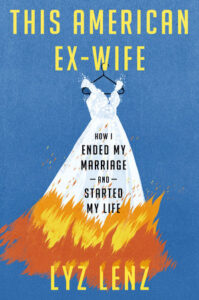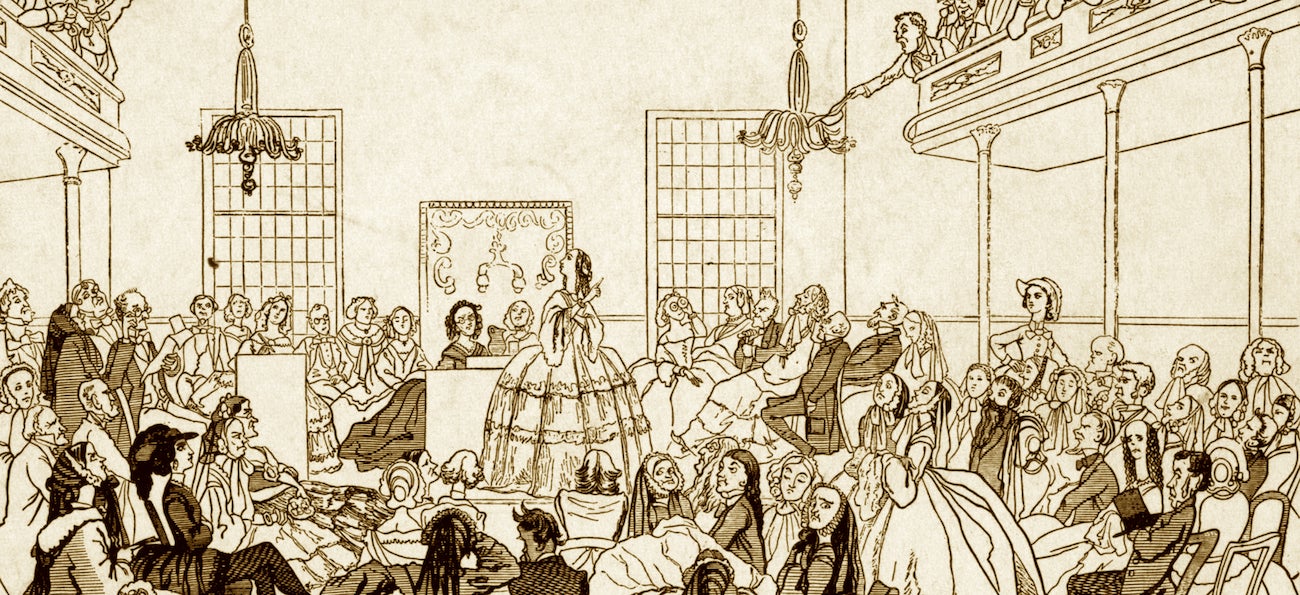Illustration: The First Women’s Rights Convention, Seneca Falls, 1848
The history of marriage is also the history of divorce. Divorce found its legal pathways because King Henry VIII couldn’t sire a male heir. In 1522, the king fought with the Vatican to obtain a divorce to marry Anne Boleyn. Famously, this didn’t work out for her. Spoiler: She was beheaded.
And Henry VIII would divorce one more wife after that. But his divorces didn’t open the floodgates to divorce in England. In fact, his bad example made England far more restrictive, and getting a divorce required an act of Parliament until 1857. In that year there were 324 divorces granted, and only three of them were instigated by women.
Americans may not have invented divorce, but we did make it great. Glenda Riley’s book Divorce: An American Tradition posits that Americans have always led the world in divorce rates. In 1620, the Pilgrims made marriage a civil, rather than a religious, agreement. Records show that the Pilgrims granted at least nine divorces, and the first was granted in the Massachusetts Bay Colony. In 1639, the wife of James Luxford was granted a divorce because her husband already had a wife. In the 1830s, the Frenchman Michel Chevalier toured America and noted that divorce was easier to attain in the new country than it was in Europe.
_______________________________
Audio excerpted courtesy of Random House Audio from This American Ex-Wife: How I Ended My Marriage and Started My Life by Lyz Lenz; Read by the author © 2024 by E Claire Enterprises LLC ℗ Penguin Random House LLC.
_______________________________
Divorce fit well with American mythos of freedom, democracy, and individualism. If men escaping the law could come to America and find a new life, why not women? In 1771 or 1772, Thomas Jefferson, never one for being good at dating his notes, began writing a brief in defense of divorce on behalf of John Blair, who wanted to end his tumultuous nineteen-month marriage. The brief was never filed because John Blair died. But Jefferson’s writing connects the freedom of divorce to the ideals of the Revolution.
Under the title “Arguments pro,” Jefferson wrote the following: “Cruel to continue by violence an union made at first by mutual love, but now dissolved by hatred. Liberty of divorce prevents and cures domestic quarrels.” It sounds liberating, but Jefferson was advocating for freedom for men and men only. The other notes in his documents show he believed that a wife was obligated to have sex with her husband and produce children. Freedom, for Jefferson, when it came to marriage and the founding of America, was freedom for white men.
Jamestown, founded as a puritanical theocracy, allowed a kind of marital separation, where the couple could live apart, the husband would support the wife, and neither could remarry. After the colonies declared independence, the southern states (except South Carolina) began to allow legislative divorces, where the couple could apply for the absolute dissolution of their marriage from the state’s lawmakers.
Overwhelmed by the number of divorce petitions, lawmakers eventually turned the process over to the courts. It’s important to note that this freedom was for white people only. Black people were still largely enslaved. But they were often mentioned in divorce petitions, where husbands blamed their wives for bearing “mulatto” children, or wives accused their husbands of cruelty for bringing enslaved women into the marriage bed.
The reasons for many of these early divorces are no different from the reasons people today have for splitting up—abuse, intoxication, and adultery. Riley’s analysis of the data concludes something that also parallels modern marriage: Most of the divorce petitions in the state of Virginia were sought by women. A lot of these women so desperately wanted to be free that they shared their private humiliations with an entire legislative body. I wonder about all the women without the means or stamina or support to seek divorces. What were their lives like? How much greater their humiliations?
*
On November 9, 1805, Robert Cartwright placed an ad in The Tennessee Gazette and Mero-District Advertiser for his runaway wife. “I do hereby forewarn all persons from crediting my wife Polly Cartwright, on my account, or harboring her, as she has left my bed and board without any just cause. I am therefore determined to pay no debts of her contracting, and will prosecute any person harboring her, with the utmost rigor of the Law.” Ads for runaway wives that mostly absolved the husbands of their debts rather than calling for the wives’ return filled the pages of early newspapers.
In the 1800s, the Midwestern states of Ohio, Indiana, Illinois, and Iowa gained reputations for quickie divorces. Ohio and Indiana eventually put restrictions on residency requirements, pushing people into Iowa and Illinois, and eventually the Dakota Territory. In 1889, the U.S. Bureau of Labor tallied 328,716 divorces between 1867 and 1886. And most of the divorce seekers, two out of three, were women.
In her book The Divorce Colony, historian April White tells the story of women who escaped to the Dakota Territory to get a divorce. One woman, Blanche Molineux, took the four-day train ride to Sioux Falls to establish residency in order to divorce her husband Roland, who had been tried for the murder of one of Blanche’s friends. Although Roland was ultimately acquitted, the trial rocked the nation, with Blanche named as the center of a love triangle and blamed for the murder. Sioux Falls at the time had become a divorce colony, where women with the means could go to establish their residencies and seek their divorces. They formed a motley band of outlaws, an Ex-Wives Club on the frontier.
Blanche got her divorce. But her notoriety brought scrutiny to the divorce colony, and lawmakers extended the time required to establish residency. Then, Nevada took up the mantle as the quickie divorce capital of America. It’s important to note that none of these quickie divorces were actually that quick; they took months, and they were reserved for those who had the means to make them happen.
Freedom was what so many American women wanted, and they would do anything to get it. After all, America had been founded on the promise of freedom. In April 1848, forty-four married women in western New York wrote to the New York state legislature citing America’s founding document, the Declaration of Independence, noting, “Your Declaration of Independence declares, that governments derive their just powers from the consent of the governed.
And as women have never consented to, been represented in, or recognized by this government, it is evident that in justice no allegiance can be claimed from them. Our numerous and yearly petitions for this most desirable object having been disregarded, we now ask your august body, to abolish all laws which hold married women more accountable for their acts than infants, idiots, and lunatics.”
That same year, American suffragists held the Seneca Falls Convention, where women argued not just that they should have the right to vote and hold property, but that marriage itself should be changed. Women, created equally, should be treated equally. And change began to happen. In 1848, New York passed a married women’s property act. It wasn’t the first—that had been passed in Mississippi, nearly a decade before. But after New York, other states followed—passing laws that allowed women to own property, keep income, and have a right to property acquired through marriage.
As women became more financially free, marriage became more about love and sex rather than commerce (or so we told ourselves). But it was a slow change. Women couldn’t get a mortgage or own credit cards without the approval of a father or husband until 1974. For centuries, rape was defined as between a man and a woman “not his wife,” establishing the fact that no matter the reality, legally, a husband could do what he wanted with his wife, and he did. Those laws began to change in the ’70s but even now, some states like South Carolina treat marital and nonmarital rape differently.
*
The story of marriage is just as much about who is included in the narrative as it is about who is excluded. The book Far More Terrible for Women is a collection of the stories of women who were enslaved in America before the Civil War. These women recount love unions ripped apart because it was more advantageous for their owners to have them married to someone else, and partnerships made for breeding purposes, only to be ended when husbands were sold away or killed.
One woman, Louisa Everett, who was ninety when she was interviewed, recalled that on the plantation where she lived, enslaved people were forced to have sex with one another. If the owner thought a certain couple would have good children, he’d force them to have sex even if they were married to other people. Everett was married to her first husband when the plantation owner, a man she called Mister Jim, called her and an enslaved man named Sam over to him and ordered Sam to take off his shirt. Then Mister Jim asked Everett if she could stand such a strong man. Mister Jim was carrying a bullwhip, so Everett said yes.
“Well,” she recalled, “he told us we must get busy and do it in his presence, and we had to do it. After that, we were considered man and wife.” Another woman, Julia Brown, recalled her aunt and uncle being married but living on two separate plantations; they were allowed to visit only on Wednesdays and Sundays. One Sunday her uncle went to visit his wife and she’d been sold. He never found her again. Slavery in America was used to prop up white families with free labor, while tearing Black families apart.
Later, government support for families, such as free childcare for working women during World War II and veterans housing, would be denied to Black families. Every cultural force in America was working to tear Black families apart, while shaming them for not being married. In Veil and Vow, her cultural history of Black marriages, sociologist Aneeka Ayanna Henderson writes, “Black women’s unfreedom is made plain through the fictional depiction of domestic or intimate partner violence, rape, and sexual assault, and the state’s violent interventions in their private lives.
These interventions, from both political and cultural institutions, often rehearse neoliberal discourse, bolstering familiar order and privatized solutions as they reduce female subjectivity to marital status. They surreptitiously encourage African American women, imagined as the least desirable, to suffer through abuse and assault in order to sustain the facade of bourgeois nuclear family, made politically important for African American people.”
It’s hard to get married when the culture views you as less desirable. Henderson calls this “marriageocracy,” a portmanteau of “marriage” and “meritocracy.” The word suggests “that a free, unregulated, and equitable romance market animates marriage and the idea that it can be obtained with the cogent but misleading trinity of individual hard work, resilience, and moxie,” Henderson explains. But this idea isn’t borne out by reality.
According to a recent Pew Research Center study, Black women are more likely to be single than any other demographic. A 2014 OkCupid survey of dating behavior from 2009 to 2014 found that Black women were viewed as the least desirable dating cohort. And if you should get married, it’s hard to stay married when the state is more likely to incarcerate Black women and Black men, and social services are more likely to get involved in their children’s lives.
Additionally, interracial marriage was illegal in many states until the Loving v. Virginia Supreme Court decision of 1967. Author Michael Warner sums it up perfectly in his book The Trouble with Normal, when he calls marriage “nothing if not a program for the privileged.”
Today, nearly half of all Black women have never been married. That’s compared with 32 percent of all American women. Marriage, simply put, can’t be a solution to societal ills, because it isn’t accessible to all people in our society. For centuries, traditional marriage was illegal for gay people. It wasn’t until 2015 that the Supreme Court recognized same-sex marriage as a constitutional right.
In the Queer Manifesto, a defining document of the social and political movement ACT UP written in 1990, the author points out that for centuries, because of stigma, many queer people were consigned to expressing their feelings of love through art, therefore defining cultural conceptions of love while being denied the ability to access the legal institutions of love. The documentary Invisible: Gay Women in Southern Music highlights this point perfectly, telling the stories of lesbian country songwriters who cloaked their sexuality to remain in the industry, writing songs that defined and expressed and reinforced notions of heterosexual love.
Marriage, simply put, can’t be a solution to societal ills, because it isn’t accessible to all people in our society.Excluded from the institutions of heteronormative marriage, Black and queer people have found fuller ways of living. In the essay “Single Black Women and the Lies About Our Love Lives,” the author Minda Honey notes,
The pandemic has only deepened my ambivalence about the supposed connection between matrimony and happiness. The surge in divorces these past few years made me question what these married women I’d often envied learned during the months they were shut-in with a spouse? Yes, the pandemic has been lonely for singles. But unlike many partnered women, I had not needed to drop out of the workforce to be the primary caregiver for children, nor had I found myself grumbling over being laden with an unfair portion of the household management. Often, when discussing singleness, there is a focus on what is lacking from a life unpartnered. Rarely do we consider what must be exchanged for a life lived with someone else.
Honey then goes on to describe the different ways Black women are redefining their relationships and their lives. Being forced out of the heterosexual marriage market has become a place of freedom rather than exclusion.
Whenever we tell the history of marriage, it’s important to know who is excluded: the poor with no property to transfer, queer people, people who are too fat or too thin, the women used for sex then discarded because they weren’t considered high class enough to be wives, the enslaved, the sluts, the single moms, women of color. These are the Liliths in the myth of marriage.
The story of Lilith is derived from the biblical story of Adam and Eve and the creation. Genesis recounts two versions of the creation, one where God makes man and women in his own image. The other is where he creates women from the rib of man. Mandaean and Jewish mythology tells the story with two women.
Lilith, the first woman, who is Adam’s equal and who rejects the Eden created by the Lord, is banished and becomes a demon. And Eve, made from man, the good woman—who still isn’t good enough—who gets both Adam and herself tossed out of paradise. Other interpretations of the Bible reject the existence of Lilith altogether. But if Western ideas of heterosexual marriage are rooted in the Christian and Jewish tradition of the union of Adam and Eve, then the woman lingering on the shadows of that story, even if she is a ghost of mythology, becomes relevant.
I imagine her hovering just outside of Eden, smoking, waiting for the others to be cast out, too. And they always are. Because it doesn’t matter how pretty you are or how good you are at roasting chicken or cleaning the house, you will fail. Your body will not produce an heir. You will commit that unforgivable female sin of getting old. You will become boring. You will nag about socks. You will eat of the forbidden fruit. Even now, the Liliths know that marriage remains a vehicle for the strict regulation of money, property, inheritance, sexuality, and female desirability. And anyone who falls afoul is tossed out of Eden.
Historian Randal Olson created a chart tracking American divorce rates over the course of 144 years. Beginning in 1867, the chart shows the number slowly rising with a dip in the 1930s due to the Great Depression and a leap in the number after WWII. The chart seems to show that when economic hardship hits America, the divorce rate drops or holds steady; after all, it’s hard to spend money on lawyers when there isn’t much money to go around and the economy is uncertain.
Historians attribute the leap in divorces at the end of WWII to the ending of the hastily cobbled together war marriages. Both divorce and marriage rates would drop in the 1950s, as women who were free to work while the men fought the war were forced back into the home. This restriction of women, and their unhappiness over it, brought about the second wave of feminism of the 1960s and ’70s, in which women fought for equal pay, the right to work, financial freedom, and no-fault divorce. These freedoms caused a wave of divorces, with divorce rates in America hitting 50 percent.
Since then, the rate of divorces has leveled out, and as I write this book the divorce rate sits at 2.3 per 1,000 people for the year 2022. Divorce is not immune to the cultural and political forces of history, because marriage and divorce are an essential pillar of society.
__________________________________

Excerpted from This American Ex-Wife: How I Ended My Marriage and Started My Life by Lyz Lenz. Copyright © 2024 by E Claire Enterprises LLC. Published in the United States by Crown, an imprint of Crown Publishing Group, a division of Penguin Random House LLC. All rights reserved.



